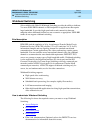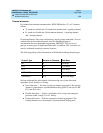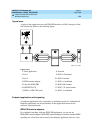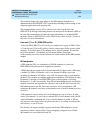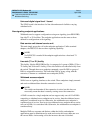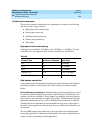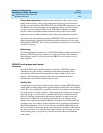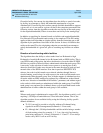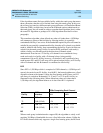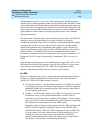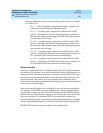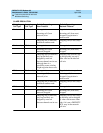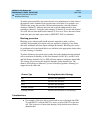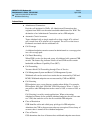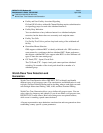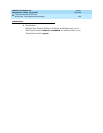
DEFINITY ECS Release 8.2
Administrator’s Guide
555-233-506
Issue 1
April 2000
Features and technical reference
1595Wideband Switching
20
If the algorithm cannot find an available facility within the trunk group that meets
these constraints, then the call is blocked from using this trunk group. In this case,
the call may be routed to a different trunk group preference via Generalized Route
Selection (GRS), at which time, based on the wideband options administered on
that trunk group, the call would be subject to another hunt algorithm (that is, either
the same H11 algorithm or perhaps an N x DS0 algorithm described in a later
paragraph).
This same hunt algorithm, when offered any other call (other than a 1,920-kbps
call) attempts to preserve idle facilities by selecting trunk(s) in a partially
contaminated facility if one exists. If the bandwidth required by this call cannot be
satisfied by any partially contaminated facility, then the call is placed on available
trunk(s) within an idle facility, thus contaminating the facility. Again, facilities are
selected via the trunk group’s facility list and with PN preference, and trunk(s)
within a facility are selected based on the direction of channel search
administered. Note that on a T1 facility, a D-channel is not considered a busy
trunk and results in a facility with a D-channel always being partially
contaminated. On an E1 facility, however, a D-channel is not considered a busy
trunk because H11 and H12 calls may still be placed on that facility; an E1 facility
with a D-channel and idle B-channels is considered an idle facility.
H12
Since H12 is 1,920 Kbps which is comprised of 30 B-channels, a 1,920-kbps call
can only be carried on an E1 facility. As with H11, the hunt algorithm uses a fixed
allocation scheme with channel 1 being the fixed starting point. Hence, an H12
call always is carried on B-channels 1 to 15 and 17 to 31 on an E1 facility (as
illustrated in the following table). When offered any other call (other than a
1,536-kbps call), the algorithm behaves as it does when H11 is optioned.
H0
When a trunk group is administered to support H0, the algorithm to satisfy a call
requiring 384 Kbps of bandwidth also uses a fixed allocation scheme. Unlike the
H11 fixed scheme which only supports a single fixed starting point, the H0 fixed
DS0s Comprising Each Channel
Facility
ISDN
Interface H11 H12
T1
T1
23B + D
24B (NFAS)
-
1-24
-
-
E1
E1
30B + D
31B (NFAS)
1-15, 17-25
1-15, 17-25
1-15, 17-31
1-15, 17-31



